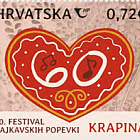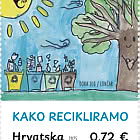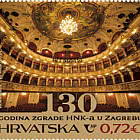Lighthouses
DAKSA
A small island of Daksa is the furthest east situated island of the Elaphite Islands, 400 metres air distance from the hotel resort Babin kuk, and 2 nautical miles from the harbour of Dubrovnik- Gruž. Covered by Mediterranean vegetation it is 580 metres long and, 100 - 180 metres wide. The highest point of the island is 24 metres above sea level. The remains of the lighthouse building on Daksa, at its western coast, evidence that here one of the smallest lighthouses of the Adriatic had been built. By the last will of Sabin Getaldić - a nobleman from Dubrovnik who financed the building of the church and the monastery on Daksa which was his property, he left it in 1281 to the church. The Franciscans settled on the island of Daksa after the termination of the building, during 13th century. Today, just the traces remain from an earlier building. In the period of the Republic of Dubrovnik the erection of tower was planned on Daksa, for which the documentation was ready in 1616. The building of the tower was given up so that for military purposes in the period of Napoleon the old monastery was used. In 1871 Austro-Hungarian Monarchy bought the islet from Franciscans and built a lighthouse on it in 1872. Already for decades there has been no lighthouse crew. The one-storey building of an area of 46 square metres is completely devastated and so is also the power-plant room next to it. The status of land ownership still prevents the initiation of renewal works. The light which once was situated in the stone tower with spiral staircase, 19 metres above sea level, has been moved to a metal tower next to the sea. The light range is 10 nautical miles. The functioning is automatized and remote-controlled. Daksa is today a favourite excursion place of the inhabitants of Dubrovnik. After the proclamation of independence of the Republic of Croatia, after 46 years of silence, the dark secret of Daksa was revealed: about wealthy and respectful inhabitants of Dubrovnik killed on 25 October 1944 today testifies a memorial with 44 engraved names. Among the victims are also two Franciscans, at earlier time owners of Daksa.
GREBENI
South of the island of Daksa in the semi-circle formation there are rocks of Grebeni. From the furthest east in the row to the coast there stretches for navigating very dangerous shelf break. Therefore has this location been chosen to build the lighthouse. On the largest rock by its surface in 1872 a lighthouse was built. The building ran parallel with the building of the lighthouse on Daksa. The lighthouse Grebeni by its light range which is visible from the distance of 10 nautical miles marks the navigation route to the coastal light at the promontory Bezdanj on the island of Koločep. The lighthouse has been totally renewed and is used today in tourist purposes. It is a one-storey building with high attic surmounted by the square tower. The light on the tower rotates 26 metres above sea level. In the ground floor there are 107 square metres of living space and in the attic there are additional 55 square metres. Although the cliffs of Grebeni have a total area of 2200 square metres, just some of the area is accessible. The steepness of the major part of the cliff surface entirely prevents access from the sea. An exception is the location where the landing place has been built, on the north side of the rock. There is a stone staircase cut into the rock, leading to a small terrace in front of the lighthouse. The activities of the lighthouse men and their family members were taking place on a reduced area. The lighthouse Grebeni is today one of the tourist symbols of Dubrovnik. Solar panels ensure the necessary power and rainwater fills up a reservoir under the lighthouse building. The light is automatized and remote-controlled, so that to tourists during their stay on Grebeni full privacy is granted. The undersea world of Grebeni is rich in various types of undersea vegetation at the rims of the combinations of gaps and smaller undersea caves. In these gaps there hover shoals of small red fishes. The sea currents around Grebeni take away the plankton mass which attracts the shoals of small fish, which in autumn are followed also by bigger - pelagic fishes.
SVETI ANDRIJA (St. Andrew)
The southernmost island of the Elaphites group is 400 metres long and in the widest part 80 metres wide, situated 6 nautical miles away from Dubrovnik. Closest to it is Lopud - two miles away. Thickly covered with evergreen trees it has steep coast that only on the west side more descends more gently toward the sea. The south coast steeply dives into sea abysses, some more than 120 metres deep. The island has been proclaimed an ornithological reserve since there dwell flocks of many migratory birds. The lighthouse was built in 1873 at the highest island plateau and the light beam is visible from the distance of 12 nautical miles. That same year also landing place was built on the north coast of the island, impressive by its high stone bridge from which a crane lifts the lighthouse man's boat when the north wind gets stronger. Stone staircase through the pine tree wood leads to the ample terrace in front of the lighthouse. The lighthouse building is a vast one-storey building with the attic and the four-sided tower. The light in the tower rotates 69 metres above sea level. At the end of the 19th century next to the lighthouse two adjoining buildings have been built – aggregate room and warehouse. The arrangement of rooms in the interior of the building is accommodated to military purpose since the Austro-Hungarian Monarchy intended to use it also as a cannon outpost. From the time of the erection of the lighthouse until today there has always been a crew in the lighthouse. Today, next to the lighthouse men in the ground floor and in the warmer period of the year in the first floor, in an arranged apartment also tourist can be accommodated. Electric power is provided by the solar equipment with transformers and the water is provided by the desalinator. In deep fissures under the cliffs very often groupers could be found. Today they moved away from the island disturbed by the sound of cruiser's motors navigating towards the harbour of Dubrovnik in the vicinity of the island. A legend about a poor woman from Lopud refers to the island St. Andrew before the lighthouse was built, when here stood the Benedictine monastery.
GLAVAT
The light of the lighthouse Glavat with the range of 22 nautical miles marks the eastern rim of the Lastovo Archipelago. Near the island with the same name there are about twenty islets, rocks and shallows - all reasons why the Austro -Hungarian Monarchy built here a lighthouse. From the shore of Lastovo the islet is 9 and from Korčula 12 nautical miles away. To the east, to Mljet there are eight nautical miles. Glavat is the highest island in the archipelago of Vrhovnjaci, and by its configuration was convenient for the lighthouse which was built in 1884, on the highest island plateau, 22 metres above sea level. The light in the tower rotates 45 metres above sea level. In the period of Austro-Hungarian Monarchy the lighthouse building was used also for the accommodation of the smaller military advance-post. The building is today entirely renewed according to original drafts. In the ground floor there are working spaces of lighthouse men, in the first floor there is a living area and in the attic there are secondary rooms. The 220 square metres of living area position Glavat among the largest lighthouse buildings in the Adriatic. The light was automatized in the 90-ties of the 20th century, when the crew was withdrawn. After the renewal of the object there is again a lighthouse man in charge for the lighthouse. In the north-west side of the island there is a hangar with the equipment for drawing ashore the lighthouse-men's boat. Rainwater is collected in the cistern situated under the entrance hall to the building. Precipitations are more often here than on other Adriatic islands in the high sea, whereof evidence green contrasts of vegetation that blooms in spring. The legend connected with the emergence of the islet of Glavat tells us about the dilemmas of gods from the Greek Olympus. In one of their quarrels the gods were unable to agree which island was more beautiful: Lastovo, Mljet, or Korčula. Poseidon then sent his adjutant to check on the spot. The adjutant admired the islands from the rim of Vrhovnjak. Poseidon got cross with him and transformed him into a small island - Glavat.
prof. dr. sc. Neven Šerić
Croatia - Recommended stamp issues
WOPA+ recommended stamp issues
| Avatar - Fire and Ash |
| Issued: 03.12.2025 |
| ›New Zealand |
| 50th Anniversary of the Founding of the 24th November Bar Scout |
| Issued: 24.11.2025 |
| ›Montenegro |
| Krisjanis Valdemars |
| Issued: 02.12.2025 |
| ›Latvia |
| Sign Language - Good |
| Issued: 02.12.2025 |
| ›Bosnia and Herzegovina - Republic of Srpska |
| In Memory of the Fallen and Murdered on October 7, 2023 |
| Issued: 08.10.2025 |
| ›Israel |
| Annual Collection Folder (New York) |
| Issued: 05.12.2025 |
| ›United Nations |
| Year Set |
| Issued: 24.11.2025 |
| ›Isle of Man |
| Shipping in the 17th and 18th Centuries - Peat Shipping |
| Issued: 05.12.2025 |
| ›Netherlands |










































